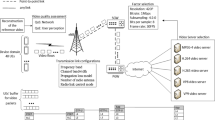Abstract
This paper presents quality of service (QoS) metrics for continuity and synchronization specifications in continuous media (CM). Proposed metrics specify continuity and synchronization, with tolerable limits on average and bursty defaults from perfect continuity, timing and synchronization constraints. These metrics can be used in a distributed environment for resource allocation. Continuity specification of a CM stream consists of its sequencing, display rate and drift profiles. The sequencing profile of a CM stream consists of tolerable aggregate and consecutive frame miss ratios. Rate profiles specify the average rendition rate and its variation. Given a rate profile, the ideal time unit for frame display is determined as an offset from the beginning of the stream. Drift profile specifies the average and bursty deviation of schedules for frames from such fixed points in time. Synchronization requirements of a collection of CM streams are specified by mixing, rate and synchronization drift profiles. Mixing profiles specify vectors of frames that can be displayed simultaneously. They consist of average and bursty losses of synchronization. Rate profiles consist of average rates and permissible deviations thereof. Synchronization drift profiles specify permissible aggregate and bursty time drifts between schedules of simultaneously displayable frames. It is shown that rate profiles of a collection of synchronized streams is definable in terms of rate profiles of its component streams. It is also shown that mixing and drift profiles of a collection of streams are non-definable in terms of sequencing and drift profiles of its constituents. An important consequence of the mutual independence of synchronization and continuity specification is that, in a general purpose platform with limited resources, synchronized display of CM streams may require QoS tradeoffs. An algorithm that makes such tradeoffs is presented as a proof of applicability of our metrics in a realistic environment.
Similar content being viewed by others
References
R.T. Aptekar, J.A. Fisher, V. Kisimov, and H. Nieshlos, “Distributed multimedia: User perception and dynamic QoS,” in SPIE, Vol. 2188, 1994.
R.T. Aptekar, J.A. Fisher, V. Kisimov, and H. Nieshlos, “Video acceptability and frame rate,” IEEE Multimedia, pp. 32–40, Sept. 1995.
W. Bauerfeld, “RACE project CIO (R2060): Coordination, implementation and operation of multimedia tele-services on top of a common communication platform,” in Proceedings of IWCA, 1992.
A.Campbell, G.Coulson, and D.Hutchison, “A quality of service architecture,” ACM SIGCOM Computer Communication Review, Vol. 1, No. 2, pp. 6–27, April 1994.
F.Christian, “Probabilistic clock synchronization,” Distributed Computing, Vol. 3, pp. 146–159, 1989.
D.Ferari, “Delay jitter control scheme for packet-switching networks,” Computer Communication, Vol. 15, pp. 367–373, 1993.
D.Ferari and D.Verma “A scheme for real-time channel establishment in wide-area networks,” IEEE Journal on Selected Areas in Communication, Vol. 8, pp. 368–379, April 1990.
D.Ferari, A.Benarjea, and H.Zhang, “Network support for multimedia: A discussion of the tenet approach,” Technical Report TR-92-072, University of California, Berkeley, 1992.
D. Ferari, A. Gupta, M. Moran, and B. Wolfinger, “A continuous media communication service and its implementation,” in GLOBECOM'92, Dec. 1992.
K. Fujikawa, S. Shimoto, and H. Shimamura, “Application level Qos modelling for a distributed multimedia system,” 1995 Pacific Workshop on Distributed Multimedia Systems, R. Jain and N.C. Lin (Eds.), Knowledge Systems Institute, pp. 44–52, March 1995.
A. Gupta and M. Moran, “Channel groups,” Technical Report TR-93-015, ICSI and University of California at Berkeley, 1993.
K.Jeffay and D.L.Stone, “An empirical study of delay jitter management policies,” Multimedia Systems, Vol. 2, No. 6, pp. 267–279, Jan. 1995.
I. Miloucheva, “QoS research for distributed multimedia applications,” 1995 Pacific Workshop on Distributed Multimedia Systems, R. Jain and N.C. Lin (Eds.), Knowledge Systems Institute, pp. 148–155, March 1995.
K. Nahrstedt and R. Steinmetz, “Resource management in networked multimedia system,” IEEE Computer, pp. 52–63, May 1995.
W.E.Naylor and L.Kleinrock, “Stream traffic communication in packet-switched networks: Destination buffering considerations,” IEEE Computer Communications, Vol. 12, pp. 2527–2534, 1982.
S.V.Raghavan, S.K.Tripathi, and B.Prabhakaran, “On QoS parameters and services for multimedia applications,” Technical Report 3167, Department of Computer Science, University of Maryland, College Park, MD 20742 USA, 1994.
S.Ramanathan and P.V.Rangan, “Feedback techniques for intra-media continuity and inter-media synchronization in distributed multimedia systems,” The Computer Journal, Vol. 36, No. 1, pp. 19–33, 1993.
P.V.Rangan, “Efficient storage techniques for digital continuous multimedia,” IEEE Transactions on Knowledge and Data Engineering, Vol. 5, No. 4, pp. 564–573, Aug. 1993.
P.V.Rangan and H.M.Vin, “Designing a multiuser HDTV storage server,” IEEE Journal on Selected Areas in Communications, Vol. 11, No. 1, pp. 153–164, Jan. 1993.
K.Ravindran and V.Bansal, “Delay compensation protocol for synchronization of multimedia data streams,” IEEE Transactions on Knowledge and Data Engineering, Vol. 5, No. 4, pp. 574–589, Aug. 1993.
J.M.Smith and K.Nahrstedt, “The QoS broker,” IEEE Multimedia, Vol. 2, No. 1, pp. 53–67, Spring 1995.
R. Staehli and J. Walpole, “Script-based QoS specification for multimedia presentations,” Technical Report, Department of Computer Science, Oregon Graduate Institute of Science and Technology, 1994.
R.Steinmetz and C.Engler, “Human perception of media synchronization,” Technical Report 43.9310, IBM European Networking Center, Heidelberg, 1993.
H. Tokuda et al. (Eds.), “Continuous media communication with dynamic control using ARTS with an FDDI network,” Vol. 10, 1992.
D. Towsley, “Providing quality of service in packet switched networks, Performance Evaluation of Computer Communication Systems, L. Donatiello and R. Nelson (Eds.), Springer Verlag, pp. 560–586, 1993.
A.Vogel, B.Kerherve, G.vonBochmann, and Gecsei, “Distributed multimedia and QoS: A survey,” IEEE Multimedia Magazine, Vol. 3, pp. 10–19, Summer 1995.
B. Wolfinger and M. Moran, “A continuous media transport service and protocol for real-time communication,” in Proceedings of the Second International Workshop on Network and Operating System Support for Digital Audio and Video, Springer Verlag, Nov. 1991.
Author information
Authors and Affiliations
Rights and permissions
About this article
Cite this article
Wijesekera, D., Srivastava, J. Quality of service (QoS) metrics for continuous media. Multimed Tools Appl 3, 127–166 (1996). https://doi.org/10.1007/BF00429748
Issue Date:
DOI: https://doi.org/10.1007/BF00429748




